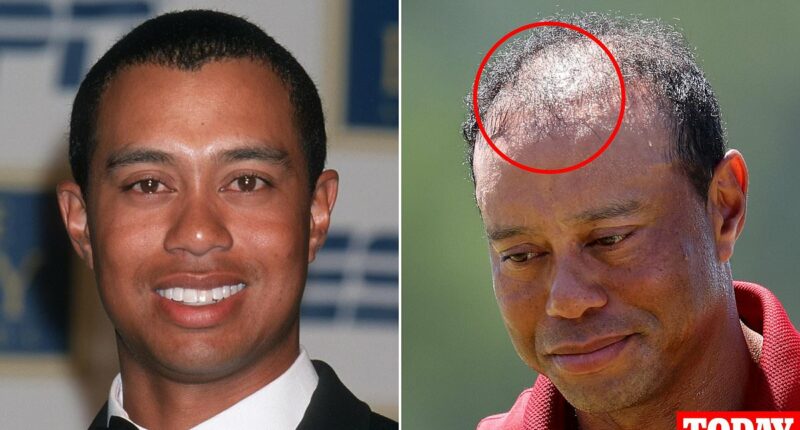Share this @internewscast.com
Tiger Woods isn’t just a golfing icon — he’s a prodigy who shattered records and redefined the sport in the late 90s and 2000s.
Throughout the years, the renowned athlete, now 49, has navigated the challenges of growing older under the public eye, beginning his journey to fame in his 20s. One aspect of this process is dealing with a receding and thinning hairline.
The opinion of a prominent hair transplant surgeon is that Woods may not have left his hair’s condition to chance and has undergone at least two hair transplants to restore his diminishing hairline.
Dr. Gary Linkov, after reviewing more than 60 photos of Woods over three decades, proposed that the few strands remaining on the top of his head are likely the outcome of surgical intervention.
But he said the surgeries — thought to have been done in 2012 and 2017 — were done too early.
Dr Linkov said Woods’ hair was a cautionary tale, and highlighted that people should wait to get a hair transplant until their hair loss has leveled off.
In Woods’ case, he received the suspected transplants before his hairline was more settled, leading to his current appearance of only a few thin hairs on the top of his head.
‘Remember that even after the age of 35, there’s still progressive loss of hair,’ he said. ‘And for some people, that can lead to a still nearly bald appearance without any proper intervention.’


Tiger Woods is pictured above in 2000, left, and in April last year. Top hair transplant surgeon Dr Gary Linkov says that the hairs on top of his scalp are the result of two hair transplant surgeries
Dr Linkov added: ‘I think the primary population of hair in the frontal area is actually the transplanted grafts.’
‘It’s not the ideal scenario,’ he continued, ‘but I think it still has given Tiger the ability to not appear bald because he has some of those hairs in the frontal zone remaining.’
About 25 percent of men experience some hair loss by 21, estimates suggest, and by age 50 about 70 percent lose some of their hair.
Surgeons suggest hair loss is most rapid in the 20s and early 30s, but can continue until someone is well into their 60s or older.
Dr Linkov did not examine Woods in person and instead based his analysis solely on photos of the golfing legend through the years.
Rumors have circulated about Woods’ alleged hair transplant for decades, although the star has not previously commented on the allegations.
Representatives for Woods did not respond to DailyMail.com requests for comment.
Dr Linkov first revealed his analysis in a YouTube video, saying Woods had likely opted for a Follicular Unit Transplant (FUT) — an older method that involves removing a strip of hair-bearing skin from a donor area like the back of the head and re-attaching it to an area where the hair is thinning.
The procedure can help to thicken hairlines, but can also leave a scar running along the back of the head — which people cover up by growing their hair out.
Many now opt for Follicular Unit Extraction (FUE), where individual hair follicles are extracted and repositioned to areas where hair is thinning, a method that avoids a large scar along the back of the head.

The above shows Woods in 2008 and again in 2013, just after his first alleged hair transplant surgery. His hairline appears to have become fuller and more advanced, which surgeons say would not happen with normal aging
In 1994, when Woods was 19 years old, Dr Linkov said he had a full head of hair and a widow’s peak — a V-shaped point in the center of the hairline.
But just three years later, Dr Linkov said there were already signs in images that his hairline was starting to reverse. In 1999, at the age of 24, images also suggest Woods’ hair was thinning at the side of his head.
By 2008, at the age of 33, Dr Linkov said Woods was losing hair at the crown of his head — the high point on the scalp where hair grows in a circular pattern.
But in 2012, his hairline suddenly became fuller, which Dr Linkov said was a telltale sign of hair transplant surgery.
‘What we see here is that Tiger’s hairline is looking a bit stronger,’ said the hair specialist.
‘And when I look at the side of the scalp… I am seeing what could potentially be some signs of FUT scarring.’
FUT surgery can leave a thin scar along the back of the head where the hair was removed. This can expand if the surgery is done repeatedly because skin on the scalp is not as elastic as in other areas, making the scar more visible.
Dr Linkov noted that after the surgery, photos show that Woods’ hair continued to thin across the top of his head.
He suggested he may have had a second hair transplant, possibly around 2017, to restore some hair to the top of his head — although the hair loss then continued.
‘This highlights the importance of proper prevention of further hair loss,’ he said, ‘or else surgical outcomes are not always that impressive years later if you don’t take the right measures to properly secure your existing hair’.
Dr Linkov continued: ‘People get overwhelmed sometimes with all the different options that exist online for their hair.
‘They’re constantly having things sold to them and marketed to them and they don’t know which way to turn, what’s actually going to work, what’s not going to work. What I tell my patients is to stick to the tried and true.’

The above shows Woods with a full head of hair in his younger years, and nearer to today, with hair lost on the top of his scalp and crown

Dr Linkov pointed to this image to suggest that Woods had a scar from FUT surgery
Woods has continued to lose hair on the crown and top of his head over recent years, Dr Linkov said, which may have prompted him to often wear a sunhat at games.
And Dr Linkov added it would be difficult for a surgeon to restore the hair at the top of Woods’ head, saying that only so much was available from donor areas, such as the back and side of the scalp.
He suggested patients should try prescription drugs finasteride and minoxidil, both approved in the 1990s and which studies show may help to slow hair loss.
The medications can have serious side effects, however, including struggles with libido, with doctors advising patients to monitor themselves while taking the drugs.
It is not clear whether Woods ever tried finasteride or minoxidil, and Dr Linkov suggested he had not used them.

















